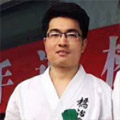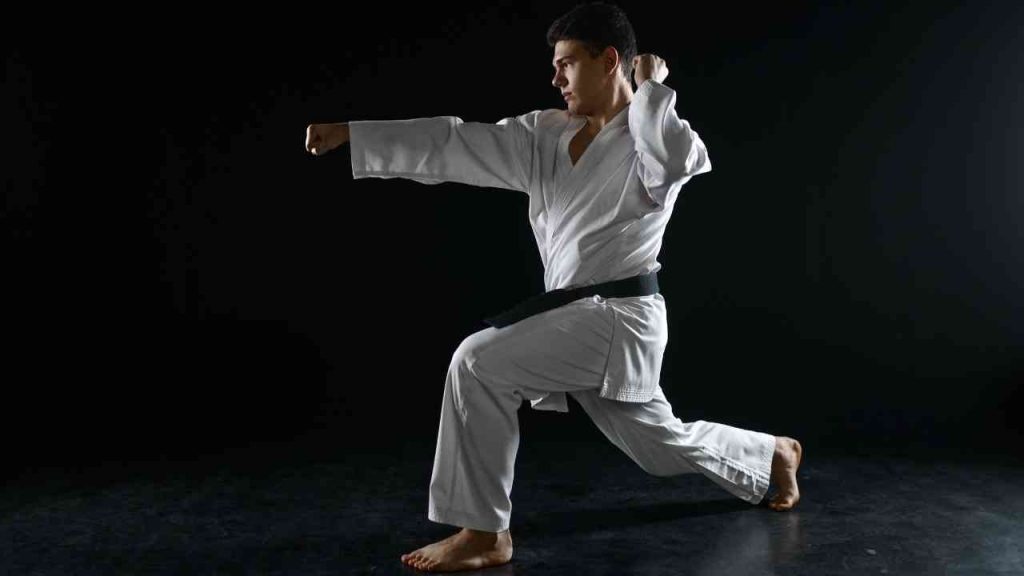Focusing more on character development and mental discipline, the Shotokan form of Karate is hugely popular across the globe. However, it is not an easy art to master. Therefore, you must have proper guidance and knowledge and that’s specifically what I will be discussing in this blog.
So, let’s get started!
Table of Contents
What Is Shotokan Karate?
Shotokan Karate is a martial art that does not incorporate the use of any weapon. The name “Shotokan” comes from a word called “Shoto” which means billowing or waving pine. However, this term was actually the pen name of the founder, Gichin Funakoshi.
Shotokan Karate focuses on wide stances and linear techniques allow the usage of hands, elbows, knees, and feet to deliver strikes quickly and effectively. The Shotokan philosophy focuses not only on self-defense but also on overall improvement. Continuous practice of Shotokan techniques has many benefits like,
- Physical and aerobic fitness
- Improved perceptibility
- Better body alignment
- Increased concentration
- Stress management
- Growth in confidence and discipline
Having said that, let’s try and trace the history and the different nuances of Shotokan Karate!
History of Shotokan Karate
Born in Okinawa in 1868, Gichin Funakoshi is considered the founder of modern karate. Throughout his life, Funakoshi had been an avid karate enthusiast. He took karate a step further and integrated philosophical aspects in his student’s karate training.
In 1936, he founded his karate style called Shotokan which was further developed by Funakoshi’s son Yoshitaka and the first headmaster of the Japan Karate Association, Masatoshi Nakayama. In honor of Funakoshi, his students created a signboard reading ‘Shotokan’ which was placed above the entrance hall where he taught.
‘Shotokan’ was the name of the first official dojo constructed by Gichin Funakoshi in 1936 at Mejiro. The dojo was damaged in 1945 due to allied bombing. The word ‘shoto’ means ‘pine-waves’ and their movement when the winds blow through them. This stands for the precise movements of the body and deep, long stances while practicing Shotokan Karate.
Shotokan Karate Belt Order
Shotokan Karate follows a dedicated belt system to rank a student. The karate belt system uses a variety of colored belts to determine an individual’s skill level. With each passing level, the color of the belt gets darker. Many also believe in the theory of the white belt becoming dirty over time and turning black, representing a black belt, the best rank.
Mentioned below is the belt ranking system in Shotokan Karate.
| Rank | Belt Color | Kata Required |
|---|---|---|
| 9th Kyu | White | Heian Shodan |
| 8th Kyu | Yellow | Heian Nidan |
| 7th Kyu | Orange | Heian Sandan |
| 6th Kyu | Green | Heian Yondan |
| 5th Kyu | Purple | Heian Godan |
| 4th Kyu | Purple and White | Tekki Shodan |
| 3rd Kyu | Brown | Bassai Dai |
| 2nd Kyu | Brown and White | Bassai Dai |
| 1st Kyu | Brown and White | Bassai DaiKanku DaiJionOr Empi |
| Shodan 1st Dan | Black | All Kata’s |
Shotokan Karate Techniques
Shotokan Karate Katas
‘Kata’ is a Japanese word meaning ‘form’. Kata is a series of standardized movements or forms which are followed in all forms of karate to practice offensive and defensive techniques. When students have to pass the belt test, they are required to perfect the kata movements.
Shotokan Karate has 26 different katas, which have been listed below.
| Kata | Kata Meaning | No. Of Moves |
|---|---|---|
| Heian Shodan | Peaceful Mind One | 21 |
| Heian Nidan | Peaceful Mind Two | 26 |
| Heian Sandan | Peaceful Mind Three | 20 |
| Heian Yondan | Peaceful Mind Four | 27 |
| Heian Godan | Peaceful Mind Five Universe | 23 |
| Tekki Shodan | Iron Horse One | 23 |
| Tekki Nidan | Iron Horse Two | 24 |
| Tekki Sandan | Iron Horse Three | 26 |
| Bassai Dai | Penetrating the Fortress-Big | 42 |
| Bassai Sho | Penetrating the Fortress – Small | 27 |
| Kanku Dai | To look at the Sky – Big | 65 |
| Kanku Sho | To look at the Sky – Small | 48 |
| Enpi | Flying Swallow | 37 |
| Jion | Love (and) Goodness | 47 |
| Gankaku | Crane on the Rock | 42 |
| Hangetsu | Half Moon | 41 |
| Jitte | Ten Hands | 24 |
| Chinte | Incredible Hands | 32 |
| Sochin | Preserve Peace | 41 |
| Meikyo | Mirror of the soul | 33 |
| Jiin | Named after the Saint | 38 |
| Gojushiho Dai | 54 Steps – Big | 67 |
| Gojushiho Sho | 54 Steps – Small | 65 |
| Nijushiho | 24 Steps | 24 |
| Wankan | Crown of a king | 24 |
| Unsu | Cloud Hands | 48 |
Shotokan Karate Bunkai
Bunkai can be understood as singular elements of each kata. For instance, if an instructor has to teach a kata to his students, he will probably break down the kata into its offensive and defensive elements i.e., bunkai. Bunkai differs for each kata because its interpretation and application change accordingly.
Shotokan Karate Stances
Shotokan karate follows a very specific stance and movement when it comes to fighting techniques. There are 16 Shotokan Karate stances. I have listed all the stances below, with a brief description of each stance.
- Heisoku-dachi – This stance incorporates the feet. Both feet must be together and it is used when bowing.
- Musubi-dachi – In this stance, the heels of the practitioner must be together but the feet should be turned out at 45 degrees. This stance is also used when bowing
- Heiko dachi – In the Heiko dachi stance, both feet are kept parallelly and it is used after bowing.
- Zenkutsu dachi –front stance with one foot forward with 70% weight on the front leg and 30% on the back leg, used in almost all Shotokan Karate katas.
- Kiba dachi – This stance mimics someone’s horse-riding and it is used while performing the various kata.
- Kokustu dachi –back stance with 70% weight on the back leg and 30% on the front leg, used while performing katas.
- Hangetsu dachi –half-moon stance which follows central weight distribution, 50% on the front leg and 50% on the back leg.
- Fudo dachi – an immovable stance that includes zenkutsu dachi, with the right leg in front.
- Sanchin dachi – hourglass stance used in two Shotokan Karate kata, Nijushiho and Unsu.
- Neko ashi dachi –cat stance is used in many kata’s, especially in Hangetsu.
- Tsuru ashi dachi –crane foot stance used in kata, Jitte.
- Sagi-ashi-dachi – heron leg stance used in kata Gankaku and Chinte.
- Kosa dachi – crossed legs stance used in kata Heian Yondan.
- Migi ashi orishiku – right leg kneeling stance used in kata Enpi.
- Renoji dachi – L shape stance with front and back foot making the letter L.
- Teiji dachi – T shape stance with front and back foot making the letter T.
Shotokan Karate Kicks
Shotokan karate also incorporates the use of legs and that too actively in the form of kicks. Some well known and often used kicks in Shotokan Karate are:
- Ashi Barai – Foot Sweep is useful in knocking an opponent off the ground.
- Fumikomi –Stomping Kick is used to targeting an opponent’s knee, thigh, or foot.
- Gedan Mawashi Geri – Low Roundhouse Kick is useful in kicking an opponent off balance.
- Hiza Geri – Knee Strike targets the opponent’s knee.
- Kakato Otoshi Geri – Axe Kick targets the shoulder bone of the opponent.
- Kansetsu Geri – Joint Kick is aimed at the side or back of the opponent’s knee.
- Kin Geri – Groin Kick is a standard self-defense kick in the groin area of the opponent.
- Mae Geri – Front Kick is also a self-defense kick aimed in the groin area.
- Mikazuki Geri – Crescent Kick aims at the opponent’s head or collar bone.
- Uchi Mikazuki Geri – Inside Crescent Kick travels in a circular motion from the inside to the outside.
- Otoshi Mawashi Geri – Downward Roundhouse Kick is angled downwards towards the target.
- Tatsumaki Senpuu Kyaku – Tornado Kick is a spinning roundhouse kick and is very powerful.
Shotokan Karate Punches
Some punches and hand strikes used in Shotokan Karate are:
- Age Zuki – Uppercut punch is a powerful technique used to strike against an opponent’s jaw.
- Enpi – Elbow strike looks similar to an ape beating down its target.
- Haishu Uchi – The backhand strike is a reverse slap.
- Haito Uchi – Ridge hand strike is an open hand method in which the artist hits the opponent with the thumb side of their open hand.
- Nihon Ken – Two-finger strike is a self-defense technique in which the artist uses two fingers to poke the opponent.
- Kage Zuki – Hook punch is a controlled punch to block the opponent.
- Nukite – Spear hand strike uses all the fingers except the thumb to target the soft spots of the opponent.
- Tate Zuki – Vertical Punch positions the fist vertically while targeting the opponent.
Is Shotokan Karate Effective for Self-defense in a Real Fight?
Of course. Gigin Funakoshi designed Shotokan Karate with the idea of self-defense in mind, hence, it can effectively help an individual strike an attacker. If practiced regularly, Shotokan Karate techniques start coming naturally to the artist. It is almost like a muscle memory after one point in time.
Consistent training can teach an individual endurance. Along with that, it also helps in building the much-needed arms, legs, shoulders, and torso strength. Additionally, the mental strength it inculcates allows the artist to take opponents of different sizes and weights without being scared and creating a mental block. It is a good physical activity to indulge in if individuals want to understand their own body closely, learn self-control, and achieve mind-body harmony.
Shotokan Karate Books to Read
In order to master any art, it is imperative to have a comprehensive knowledge of the same. Shotokan karate needs dedication, willpower, and constant commitment. Therefore, you must try to build up as much knowledge as you can. Hence, I have mentioned here is a list of books that can help you learn more about Shotokan Karate.
- The Shotokan Karate Bible: Beginner to Back Belt
- Karate-Do Kyohan: The Master Text
- Shotokan Karate: Its History and Evolution
- Shotokan Karate:: Your Ultimate Grading and Training Guide (White to Black Belt)
- 26 Shotokan Katas: Reference Manual
Final Words
The Shotokan form of Karate requires complete dedication, determination, and inner-will as it not only focuses on physical strength but mental well-being as well. Curious about the difference between Shotokan and Kyokushin, check our article: Shotokan VS Kyokushin.


